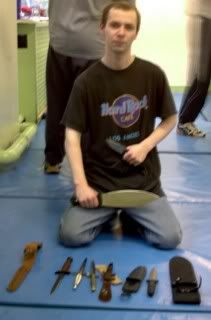THE FAIRSWORD“ W.E Fairbairn’s Improved Smatchet Design
by
Phil Matthews
In 2005 I gave a presentation to a CQB Services Seminar on the evolution of W.E Fairbairn’s edged weapon designs, it made mention of the Shanghai knives, FS Dagger and Smatchet and concluded with a brief mention of the FairSword.
 [Phil during his presentation]
[Phil during his presentation]The nature of the game being what it is I never thought that we would learn much more about that last blade. It was a mysterious design from over half a century ago, there was little hard information out there and there were also far too few of them in existence.
Towards the end of the war Fairbairn (in America on loan to the OSS still) had developed his idea for the FairSword; this blade was a radically improved design over the Smatchet.
From All In Fightingâ€, 1942

NO. 29 – THE SMATCHET
The psychological reaction of any man, when he first takes the Smatchet in his hand, is full justification for its recommendation as a fighting weapon. He will immediately register all the essential qualities of a good soldier-confidence, determination, and aggressiveness.

Its balance, weight, and killing power, with the point, edge, or pommel, combined with the extremely simple training necessary to become efficient in its use, make it the ideal personal weapon for all those not armed with a rifle and bayonet.â€
FairSwordOnly a very few prototypes were constructed – one type was made with small ball type striking pommel, a further refinement was made to one of the prototypes in the form of a hooked pommel similar to the one the Smatchet had. This was the favoured design prevalent in the patent drawings Fairbairn copyrighted.
Visually there is much that it similar between the FairSword and its predecessor, the real improvements were an elongated, more tapered blade and a dramatic lessening of its overall weight.
It also used much more advanced materials for both it and the sheath's construction.
The sheath was a radical improvement over that of the Smatchet.
Constructed from a more durable light plastic (rather than leather) it was harder wearing and more useful for the field, it was also more appropriate for Jungle Warfare where organic materials would soon perish and rot.


Instead of a single carry option the sheath had two; one side had a cross draw angled moulded belt loop and the other a low slung belt loop and two tool inserts. The tools were to aid in cleaning the main blade or pulling rounds apart for making fires.

A small number of prototypes were made and Fairbairn convinced the OSS to conduct trials into its usefulness both as a weapon and survival tool. These were held and deemed successful so in late 1944 he pushed for this weapon to replace the Smatchet (also known/termed by the Armourers as the “Bolo”) in the OSS Inventory. Two problems stopped this:
1. The War was almost over apart from the German and Pacific campaign’s
2. The OSS Armouries held over 3,000 Smatchets in storage alone
In light of the sheer expense of suppliers retooling and with the growing realisation that the war was almost at an end the OSS declined to take the FairSword up. The only blades ever made were the few prototypes that had already been created; it appeared that this Fairbairn design was to fade away into obscurity.
Up to DateYou meet a lot of people in the research game, I was extremely fortunate that in the summer of 2010 I met with the noted British knife researcher Ron Flook. He is the author of the seminal book British and Commonwealth Military Knives and is also the owner of an original FairSword prototype which he brought to our meeting.

The knife is very blade heavy and much more edge pronounced than the Smatchet, it has a much more tapered blade also.
The biggest clue to the origins of the blade were in the markings, as you can see a large stamp was tooled into the knife.

Showing the use of the more advanced materials (as with the sheath), although quite badly scratched the grip is actually a clear resin or plastic. It is also a much larger handle than those of any Smatchets I have handled.

During the course of our conversation Ron told me that he was originally offered the FairSword by an American collector for 600 dollars, he didn’t know if he really wanted to sell it and Ron didn’t really know if he wanted to buy it. The same collector came back the next year and offered the same blade again for 500 dollars – this time it was bought and sold!
 [The author with Fairsword]
[The author with Fairsword]I was extremely privileged to be able to view and hold this truly historical piece, as one of a few ever made I am sure that it was held by Fairbairn himself at some point.
Ron has some interesting projects going on at the moment and I wish him every success, his seminal work
British and Commonwealth Military Knives is out of print at the moment but well worth searching for second hand.
There may be plans for re-releasing some of his fantastically well researched books; we will of course update our readers if this happens!
In the meantime one of my favourite articles on World War Two knives is available
here , I really recommend its reading as it's typical of Ron's desire for accuracy and truth something I try to echo in my own research.
Copyright thebristolbloke 2010
